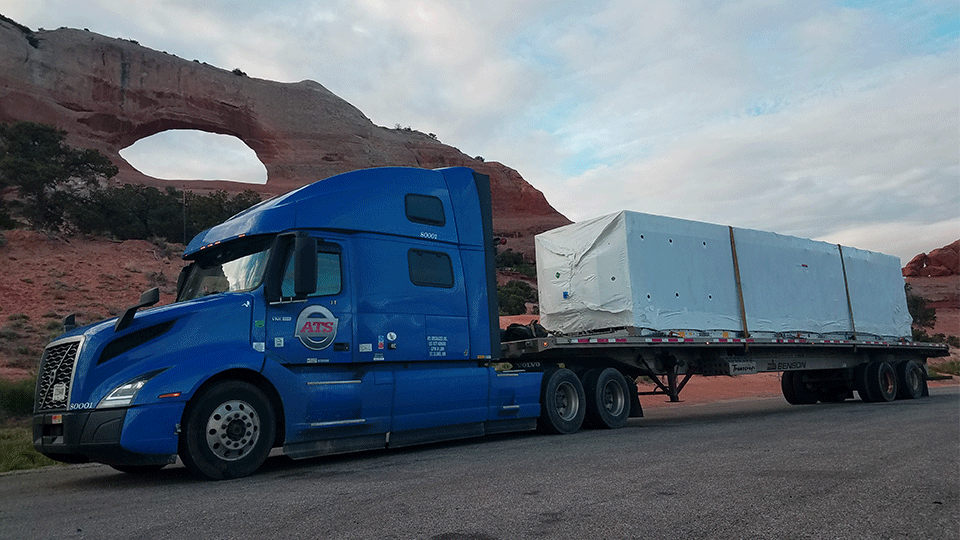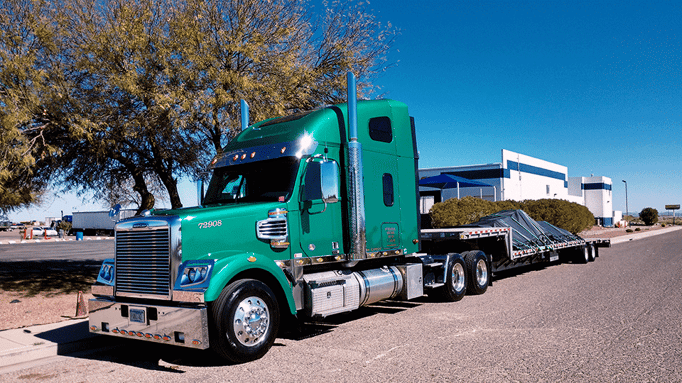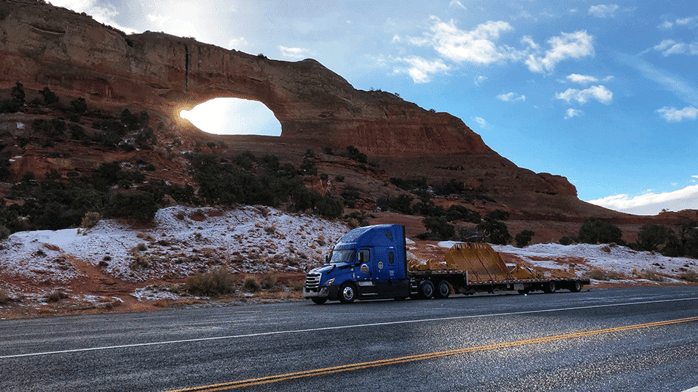
More than $100 billion. That’s how much money shippers — across the U.S. — spent moving their open-deck freight in 2021 alone. This number — which reflects a total that has steadily risen in recent history — is likely to continue its upward trend in the years ahead.
Most of these dollars were allocated unavoidably; indicating nothing more than the cost of doing business in a competitive space. That said, it’s reasonable to wonder whether every dime was truly managed efficiently.
As a shipper with dollars and cents on the line, you understand the importance of saving money wherever possible. And, even though “dollars spent” often equates to “level-of-service-received” in the transportation industry, it’s not impossible to save money here.
There’s no reason that moving these goods should break the bank or leave you scrambling to meet your budgetary goals.
Honestly, saving money in the transportation world — regardless of which service you utilize — comes down to the convenience of your load in the eyes of the provider(s) you use.
In this article, you’ll learn how to shave some dollars off of your flatbed freight rates by doing just that.
Here at Anderson Trucking Service (ATS), our specialized division has been helping businesses across North America move their open-deck freight since 1955. During this time, we’ve witnessed flatbed transportation pricing evolve to match changes in supply and demand — as well as a number of other factors.
Over time, ATS Specialized has become acutely aware of what it truly takes to execute these shipments. Using this knowledge, and years of experience, we’ve pinpointed some areas where well-organized companies can get a few dollars back on their open-deck loads.
To help you achieve these cost savings on your next freight move, below we’ve outlined them.
Eight ways for you to save money on your flatbed shipments are:
- Lengthen your pick-up/drop-off date windows
- Expand the loading/unloading timeframes you allow
- Find ways to expedite your loading processes
- Consider allowing both live and drop-trailer loading
- Give accurate, specific and detailed shipment information up front
- Give your provider(s) trailer type flexibility
- Avoid the use of “extra” transportation equipment
- Give carriers ample lead time to operate with
Without taking these factors into account when planning out their transportation processes, many shippers end up overpaying for their flatbed solution. Let’s avoid this going forward. . .
1. Lengthen Your Pick-Up/Drop-Off Date Windows
Providing transportation services, no matter which type, is an operationally-intensive process. This is especially the case for asset-based carriers (as opposed to third-party companies).
You see, to make money, flatbed trucking companies need to keep their assets moving by booking them out to various shippers well into the future. For this reason, it’s difficult for most flatbed carriers to meet the needs of shippers with rigid pick-up and drop-off demands.
Without a bit of leeway — on day(s) of the week and time(s) of the day — a carrier's ability to smoothly incorporate one company’s demands onto their “set” schedules dwindles. And, when it gets more difficult — or more inconvenient, rather — to service a shipper’s load alongside their other commitments and the needs of their drivers, flatbed trucking companies must increase their prices.
Companies that require their flatbed providers to pick-up/drop-off freight on a single, specific day may be inadvertently increasing the price they pay as a result.
Sure, in many cases this date precision may be unavoidable. But when it's not, opening this window will help you save money on these shipments.
For example, shave some dollars off of your flatbed freight rate by asking your provider for a quote on a pickup between Monday and Wednesday — as opposed to simply requiring a Tuesday truck.
With this date-window flexibility, your flatbed carrier will be able to plan your shipment based on a wider pool of options — perhaps even routing a truck that, at the moment, is located 500+ miles from your origin but can get there by Wednesday.
2. Expand Your Loading/Unloading Timeframes

Allowing a bit of leeway on your pick-up and delivery hourly timeframes is another way to save on your flatbed shipping.
This, once again, is tied to a carrier’s ever-present desire to make the most of their assets. Most specifically, rigid loading/off-loading windows make it challenging for flatbed truck drivers to maximize their on-duty service hours — coined their “hours of service” or HOS.
Hours of service regulations, legally mandated by the Federal Motor Carrier Safety Administration (FMCSA), limit truck drivers to 14 hours of total “working” time per day. Each of these 14-hour stints — 11 hours of which can be dedicated to driving — must be followed by a 10-hour break period.
As you can imagine, for flatbed trucking companies looking to keep their drivers moving, these HOS regulations make achieving efficiency difficult. This difficulty is only compounded when a shipment comes with a strict timeframe (like between 8 a.m. and 10 a.m.).
In these instances, a shipper’s cost of procuring services rises to match the inconvenience flatbed carriers face when trying to meet rigid demands.
Making this work often takes significant planning and sacrifice from a flatbed carrier — forcing them to forgo other shipments or plan out other loads accordingly.
As such, expect to pay more for tight-window shipments. Save money on your flatbed loads by offering more timeframe leeway on their front/back end. Here are some examples of how:
- Instead of planting firmly on an 8 a.m. pick-up appointment, try a timeframe of 8 a.m. to 3 p.m.. instead. (The bigger the window, the better likelihood your preferred carrier can match an available truck to your shipment).
- Adjust your required delivery time frame from 2 p.m. sharp to a wider window of 10 a.m. to 2. p.m.
- Instead of requesting a driver pick up your load on a Friday at 4 p.m. and sit on it until Monday at noon, adjust your schedule to allow for a same-day pick and drop.
- Consider asking your carrier what drop-off time would work best for them and see if your schedule could match.
3. Find Ways To Expedite Your Loading Processes
Prolonged loading and unloading procedures at a pick-up or drop location can have a negative impact on flatbed trucking companies as they try to keep each driver on top of their HOS.
A truck driver’s on-duty clock doesn’t stop running while they’re sitting at a facility or job site getting loaded/offloaded. For this reason, when it takes a prolonged period to accomplish these activities, flatbed shippers see their costs rise to reflect the rising commitment a carrier is making to their business.
With only 14 hours of on-duty time per day, flatbed trucking companies vigilantly monitor how this time is allocated. And, once your loading/unloading process exceeds 2 hours on either end, expect to face a detention charge (as much as $100 extra per hour).
Additionally, trucking companies and their drivers tend to steer clear of companies who they know — based on prior experience — will fail to get them moving again expeditiously. And, in the end, these businesses often find themselves paying more to secure a truck for their load in the future.
Though these loading-time-related price hikes can be damaging over time, avoiding them is also possible.
Expedite your loading processes, ensuring each truck is in and out of your location in a timely manner by:
- Staging products according to truck arrival order
- Avoid floor loading freight wherever possible
- Hiring a lumper service when necessary
- Bringing on extra help internally during peak seasons
Although this is by no means a comprehensive list, doing these — and things like these — will help you save money on your flatbed freight in the future.
4. Consider Allowing Both Live and Drop Trailer Loading
Locking yourself into a single set of options will do you no favors in the flatbed transportation world. Refusing to accept a set of solutions, although your decision to make, will increase the price you pay.
One way we commonly see this issue come up — as it relates to open-deck shipping — is in the form of “pre-load only” facilities. At these locations, where companies have decided to only allow drop trailers and have fully restricted live-load access, flatbed prices tend to rise.

Without letting a flatbed trucking company match their current capabilities — which at any given moment might only include live-loading — to your requirements, prices increase.
In these scenarios, a bit of flexibility can go a long way. Consider opening yourself up to the option of live-loading a trailer. Doing so will increase your pool of viable options and, as a result, drive down the price of securing a flatbed solution.
Although your volumes, commodity types and/or timelines may make this impossible, we recommend you employ this change where applicable.
5. Give Accurate, Detailed and Specific Shipment Information Up Front
No matter how well you plan or how much flexibility you give your flatbed carrier(s), confusion on where to go, what they’ll be hauling and where they’re taking it, can throw everything off track.
Too often, flatbed shippers are subjected to re-consignment fees, stop charges or permitting issues (on their oversized freight) because of a miscommunication on the front end.
To avoid these issues — and the price hikes that accompany them — you’ll want to make sure to list the following things when booking your flatbed shipments:
- Freight dimensions (height, weight, length, width)
- Commodity specifics (what is it?, Are there sharp edges?, Will tarping be required? etc.)
- Contact information for all parties (buyer, seller, shipper, consignee, etc.)
- Detailed location information (addresses, zip codes, street names, relevant landmarks, where to park, etc.)
The more detailed you get, and the easier you make it for your flatbed driver to understand your requirements, the better off you’ll be. Significant issues can occur when wires get crossed, forcing plans to be completely reworked. Always remember, when it comes to flatbed transportation: communicate twice, ship once.
6. Give Your Provider(s) Trailer Type Flexibility
In flatbed shipping, as is the case for other transportation methods, supply and demand greatly influence the final price you pay. And, in the interest of saving money on these loads, it stands to reason that increasing your supply of options is your best route forward. You’d be right.
As your viable supply of flatbed solutions diminishes for any given load, while the demand for flatbed services in your area holds steady, prices rise.
And, in a tight market like today’s — where the supply of open-deck trailer space is consistently lower than the demand for their services — securing affordable rates can be difficult.
That said, sometimes shippers find themselves stuck in a rut; opting to stick with a tried and true trailer type and refusing the use of others.
This method for sourcing capacity ends up haunting these companies in the end — increasing their price to match their finite pool of options.

Save money on your flatbed shipments by keeping an open mind as to which trailer types you use. Should your carrier suggest that — based on the information you’ve given them — a step-deck would work just as well as a traditional 48-foot flatbed, consider allowing them to send one your way.
Instead of refusing this solution, making your carrier’s task more difficult and potentially having to wait for an available flatbed, go for it.
Some other alternative solutions offered by your flatbed provider(s) may be:
- Using a flatbed Conestoga trailer
- Using a hot shot trailer for smaller open-deck loads
- Using a 53-foot instead of a 48-foot flatbed
Whatever their solution might be, don’t dismiss it out of hand — especially if this company has met your needs well in the past. Save money on your flatbed shipments by keeping an open mind.
7. Avoid The Use of “Extra” Transportation Equipment
As a general rule of thumb, when it comes to flatbed shipping, the more additional equipment you need, the more you should expect your load to cost you. From a trucking company’s perspective, these loads are difficult to price competitively for two reasons.
-
Not Every Driver is Equipped With These Items
When, for example, a shipper requires additional considerations like an extra set of tarps for “gift wrapping” purposes or some extra padding (carpets/savers) on sharp corners, the specialization of these loads rises. Simply put, flatbed trucks are only given a fixed set of equipment to use.
Any load with requirements that exceed these thresholds becomes a bit more difficult to service — forcing carriers to find a truck with the equipment necessary to meet these needs, decreasing your pool of options.
-
Using This Extra Equipment Takes Effort and Time
Tarping, as an example, is an inconvenience and extra effort undertaking that — with assistance from the standard tarp charge — drivers must be compensated for.
Some shippers relieve this burden by helping drivers throw tarps or offering sheltered areas where they can do so (when harsh weather makes this worse). That said, other businesses make this more difficult still, asking truckers to “gift wrap” cargo by fully covering it on the top, bottom and all sides.
As you might imagine, loads with this requirement — and requirements like this — can be really unattractive to drivers as they are both time and labor-intensive.
Here are some ways to avoid the price hikes that accompany these kinds of flatbed shipments:
- Consider forgoing tarping altogether (particularly on shorter hauls) and allow your carrier to wash a shipment before its drop-off time.
- Shrinkwrap freight on the front-end to avoid gift-wrapping it entirely.
- Give your provider the option to utilize a Conestoga trailer
Related: Should I Use a Conestoga or Tarp My Freight? (An Honest Comparison)
8. Give Carriers Plenty of Lead Time to Operate With
Time is money in many aspects of your business, this is especially true when it comes to the transportation of your freight. For this reason, it’s important for you to understand how damaging urgency can be.
Without giving your flatbed trucking company enough notice prior to the moment your shipment needs to load, your price will rise..
Although it will vary based on the complexity of your load, including its length of haul and destination location, a good amount of lead time usually falls between 24 and 72 hours.
Once your total lead time edges into the same-day pick-up range, your freight rate will increase exponentially — forcing you to pay up to 50 percent more for the same shipment.
Related: How Does Lead Time Impact Freight Shipping Price?
Understand Your Flatbed Rates Intimately And Save
Now that you have these eight tactics to employ in the future and some more information on what increases your freight rates, let’s take this a step further.
Understanding your flatbed freight quotes on an intimate level — including exactly how they’re calculated — will help you move your freight budgetarily going forward.
Check out this article on What Does Flatbed Shipping Cost [8 Factors to Know], for an in-depth view of this topic.
Finally, if you found this article informational and would like to be notified the next time we post a piece of educational content, subscribe to our Learning Hub today!




